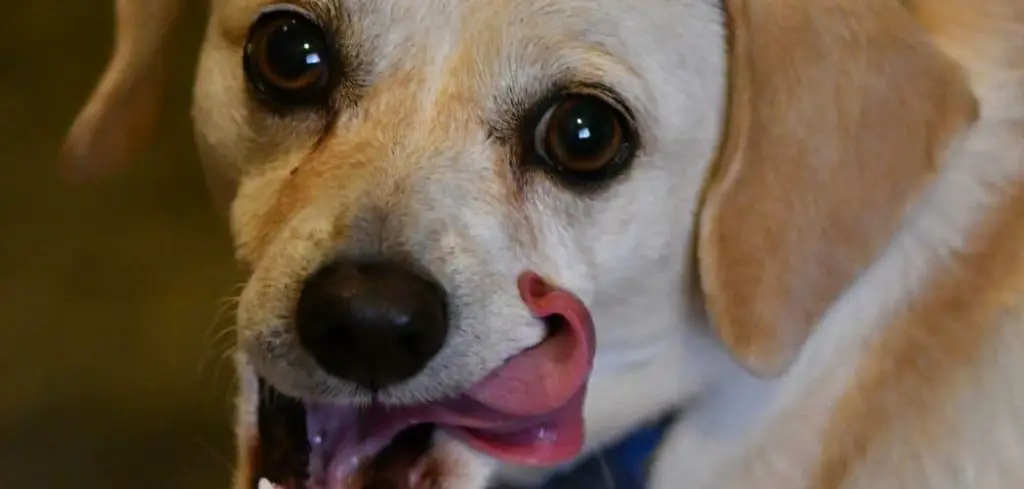Panting and excessive licking in dogs can be signs of discomfort or underlying health issues that warrant attention. These behaviors may indicate anything from stress to skin problems.
We outline the common reasons why dogs may pant and lick a lot, what you can do at home, and when to seek veterinary help.
Dog Panting and Licking a Lot — Why It Happens
Panting combined with excessive licking often points to stress, nausea, or pain. Dogs may lick surfaces, themselves, or even the air as a way of self-soothing when they feel uncomfortable. Sometimes it’s related to gastrointestinal upset, such as acid reflux, while in other cases it may signal anxiety or a side effect of medication.
If it becomes frequent or is paired with restlessness, vomiting, or loss of appetite, it’s best to have your vet check for underlying issues.

Dog Panting and Licking a Lot: Common Causes
Stress and Anxiety
Panting and licking can be signs of stress or anxiety in dogs. When dogs feel anxious, their bodies produce adrenaline, which can lead to increased panting and self-soothing behaviors like licking.
Common triggers include separation from their owners, loud noises, or changes in their environment.
Signs of anxiety may include pacing, whining, drooling, or attempting to hide. Long-term anxiety can affect appetite, energy levels, and overall well-being.
Read more: Dog Panting and Licking Floor (Here’s Why)
Oral or Dental Issues
Dental problems can cause dogs to lick excessively. Pain from gum disease, tooth decay, or oral injuries may prompt your dog to lick their lips, paws, or objects to alleviate discomfort.
Panting may accompany oral pain due to stress or difficulty eating. Owners may notice bad breath, swollen gums, or reluctance to chew toys or food. Dental care and veterinary evaluation are essential to prevent worsening pain or infection.
Nausea or Digestive Discomfort
Dogs often lick excessively when they feel nauseous or have stomach upset. Panting may also occur as a response to nausea, anxiety, or pain associated with digestive issues.
Signs include vomiting, drooling, refusing food, or restlessness. Conditions such as gastritis, pancreatitis, or ingestion of something toxic can trigger these symptoms, requiring prompt veterinary attention.
Skin Irritation or Allergies
Panting and licking may indicate irritation caused by skin issues or allergies. Dogs often lick areas that are itchy, inflamed, or painful, including paws, legs, and the face.
Allergic reactions can result from food, environmental triggers, or contact with irritants. Other signs include redness, rashes, hair loss, or scabs. Identifying the underlying cause is crucial for proper treatment and relief.
Pain or Discomfort
Excessive licking and panting can signal pain elsewhere in the body. Dogs often lick at areas that hurt, whether due to arthritis, injury, or internal discomfort.
Panting accompanies pain as the body attempts to regulate stress and manage discomfort. Owners may notice limping, difficulty lying down, or changes in behavior such as irritability or decreased activity.
Medication or Toxicity
Certain medications or toxins can trigger panting and licking in dogs. Some drugs may increase thirst, agitation, or nausea, while exposure to household chemicals or plants can lead to discomfort and licking behavior.
Immediate veterinary care is needed if poisoning is suspected. Watch for vomiting, diarrhea, tremors, or lethargy along with panting and licking.
Read more: Dog Panting and Licking Me (What it could mean)
What to Do If Your Dog Is Panting and Licking a Lot
Observe your dog’s environment and recent activities. Identify potential stressors, allergens, or items your dog may have ingested. Removing triggers can reduce panting and licking.
Ensure access to fresh water at all times, especially if panting is excessive. Hydration supports overall health and may help reduce stress-related panting.
Check for visible skin issues, oral problems, or signs of pain. Gently inspect your dog’s paws, ears, and mouth, but avoid causing additional stress or discomfort.
Provide a calm, comfortable environment for your dog. Reducing noise, maintaining a consistent routine, and offering reassurance can help alleviate anxiety-driven behaviors.
Consult your veterinarian for a thorough evaluation if panting and licking persist. They can check for underlying health issues, prescribe treatment for allergies or pain, and recommend behavioral support if anxiety is a factor.
When to Call or Visit Your Vet
Immediate veterinary attention is necessary if your dog exhibits:
Persistent or severe panting and licking
Vomiting, diarrhea, or refusal to eat or drink
Signs of pain, limping, or difficulty moving
Swelling, redness, or wounds on the skin
Lethargy, disorientation, or collapse
Early intervention can prevent complications and improve your dog’s comfort and quality of life.
Read more: Dog panting excessively (Here’s Why)
Key Takeaway
Panting and excessive licking in dogs can signal stress, pain, nausea, or underlying medical issues.
Observing your dog closely, maintaining hydration, minimizing stressors, and seeking veterinary care when needed are essential steps.
Early recognition and proper management can help ensure your dog stays healthy, comfortable, and happy.
